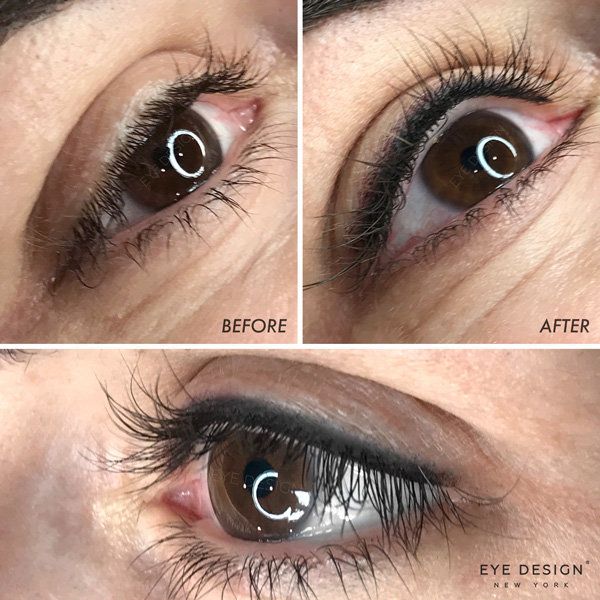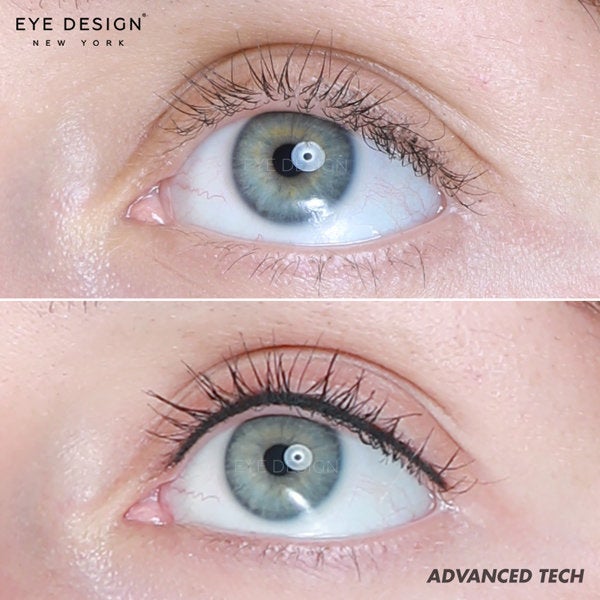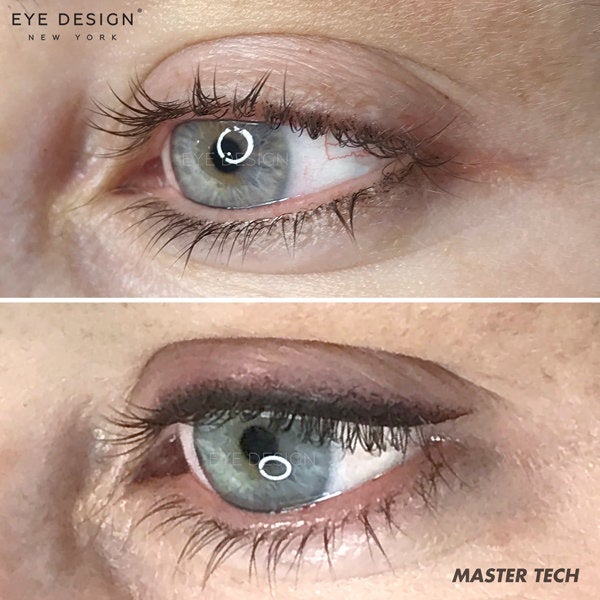
Thinking of getting your makeup permanently applied? Maybe you hate applying your eyeliner daily, or you aren’t able to apply it as precisely as you’d like, or maybe you just hate the constant struggle of trying to achieve the perfect cat eye. Whatever your reasons, you may find a solution in permanent eyeliner.
We spoke to experts in the field to find out all there is to know about the process, how long it takes ― and perhaps most importantly, how long it lasts.
Is permanent eyeliner just like a traditional tattoo?
First of all, it’s important to note that permanent eyeliner isn’t really permanent (more on that later). It’s just the term that the industry uses, and is more accurately semi-permanent. (If you want to get really technical, Rob Falco, co-owner of ElleBrow Microblading & Permanent Makeup Studio, told HuffPost that it’s considered permanent because the pigment will remain in the skin forever, but the longevity of the color and its visibility will eventually fade.)
Permanent makeup is sometimes also referred to as tattooed makeup because the process is similar to getting a regular body art tattoo: A needle is used to deposit ink into the skin. But according to Rina Meyer, general manager at Eye Design New York, the process isn’t the same as getting a tattoo because “the pigment is deposited only into the first layers of the skin.”
The ink used for regular body tattoos is formulated differently and “goes much deeper,” she said.
Additionally, Kira Tai of Tai Brows told HuffPost, “Body art inks are permanent, and cosmetic inks are semi-permanent. [Cosmetic inks] have less of of a metal base in them, metal being the component that makes it permanently adhere.”
There are reasons to be cautious, especially if you’re on Accutane.
Aside from the difference in inks and techniques, the preparation for permanent or semi-permanent makeup application is “basically just like any other tattoo,” Falco told HuffPost.
As such, it carries the same risks and contraindications that would apply to a regular body tattoo, he said.
“As a precaution, we ask [clients] to stop taking any blood thinners for three days prior, even things like aspirin, Advil, fish oils, certain vitamins, to minimize any potential bleeding, which normally doesn’t happen,” he said.
Meyer also noted that if you’re looking to have any Botox or other injections in the eye area, you should definitely get that done before having the eyeliner applied. You should also make sure you’re fully healed at least two weeks before you’re scheduled to have your liner applied.
And if you’re pregnant or nursing, or have diabetes or other serious illnesses that affect your immune system and ability to heal, you may not be an ideal candidate, Falco said.
If you’re already taking medication, it’s a good idea to speak to your doctor about it before you go ahead with your permanent or semi-permanent makeup application, Meyer said. For instance, if you’re using Accutane (or other retinoids), you need to be off the medication for six months before you can have permanent or semi-permanent makeup applied, Tai said. (Accutane, the brand name for isotretinoin, has been thought to interfere with wound healing, though it may not always be the case.)
Your lash extensions have got to go.
Remove them at least one or two days (or up to a week, to be extra safe) before you have the cosmetic ink applied, said Ant Falco, co-owner and technician artist at ElleBrow. If the extensions are removed too close to the appointment, there may be glue left behind on the lash line, which could interfere with the ink.
Meyer added that lash extensions can be reapplied once the liner has healed.
Leave your contact lenses out, too.
If you wear contacts, Tai said you need to take them out before the procedure. You should also be prepared not to wear them for a few days after, she added. As Rob noted, your eyes may be a little swollen or tender following the application.
There’s more than one type of eyeliner to choose from.
Everyone we spoke to explained that there are generally two permanent eyeliner styles.
First is the tightline, which involves adding the pigment between the layers of your eyelashes to darken your lash line, leaving you with a subtle lash enhancement, Tai said. This option is “a lot [thinner] than an eyeliner, and it’s considered very natural-looking,” she added.

Then there’s eyeliner, which is “a step above” the tightline, according to Tai.
Meyer added that for the eyeliner application, “the pigment is actually applied above the lash line and it’s drawn almost as if you were to put a liquid eyeliner on. It’s mostly for people who wear that look on a daily basis and they want to stop having to do it.”
She also noted that the technician will work with the client and take into account their facial features to determine what size and shape the eyeliner should be.
How long does the procedure take?
“It depends on how [thick] the client wants it,” Ant Falco said. “If they want traditional eyeliner, it can be done in one hour, including numbing and pre-drawing, but if they want a wing or cat eye, it would take longer.”
Tai said that her clients can expect to be with her for about two hours, including for the numbing process, which takes about 30 minutes. For a stronger eyeliner line, it could take two and a half to three hours, she said, noting that she gets her clients involved in the design to make sure the final product will be exactly what they want.
What about the pain? Does it hurt?
Everyone we spoke to said that a numbing cream is applied to the area prior to the actual procedure. Once the effects of the cream kick in, the whole process should theoretically be pretty painless, Meyer said.
However, everyone has a different pain tolerance, which means some people might find the procedure to be only minimally uncomfortable, while others may find it to be very painful (even with a numbing cream), Ant Falco said.
For comparison’s sake, Meyer said she’s spoken to some clients who’ve said their eyeliner procedure was more painful than microblading, though she also noted they’ve never had any clients who needed to stop in the middle of an application because of the pain.

What’s the healing process like?
Once you get your eyeliner applied, there’s really no down time. You can leave and go about your daily tasks and even drive yourself home, Tai said. The one thing you can’t do is wear makeup, especially mascara (which is pretty much full of bacteria after the first use). Meyer advised against going to saunas or pools as well.
You may experience some scabbing as your liner heals, but it will likely be minimal, Tai added. If you do have scabbing, do not pick it off, Meyer stressed.
“You just notice little black flakes fall out of your eyelashes over the course of a couple days,” she said.
Everyone we talked to said a tightline application should generally heal within three to seven days, but a thicker eyeliner application may take seven to 10 days.
You should definitely avoid touching or rubbing your eyes while they heal, so you don’t spread any germs or bacteria around the area.
How long does it last? And if you hate it, will it ever fully disappear?
The “tattooed” eyeliner typically lasts about a year, Meyer said, though Ant Falco noted it could last two or three years. However, the pigment will eventually fade. Meyer said many of her clients come back after about a year to get touch-ups.
If you eventually decide you don’t want the eyeliner, it’s possible for it to completely fade in one to three years. Everyone’s skin holds the pigment differently, so it’s tough to say how long it will take for the liner to become invisible.
And the big question: How much does it cost?
Having your eyeliner applied this way definitely doesn’t come cheap. Rob and Meyer noted that the initial application will typically run anywhere from $500 to over $1,000, depending on what you’re looking for. Tightline application will generally be less expensive than the thicker eyeliner. As for touch-ups, Meyer noted that those could cost around $200 to $700.
